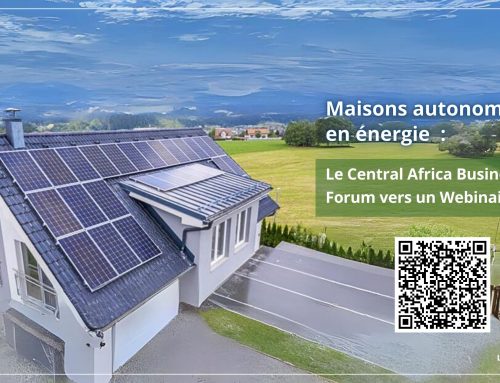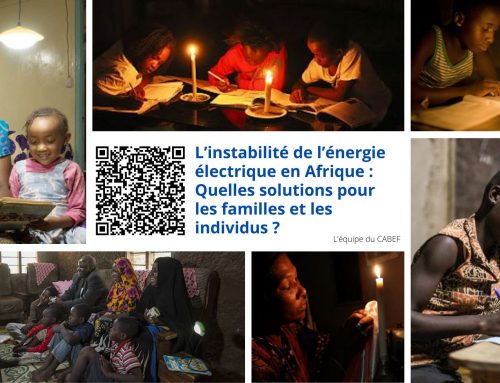The Instability of Electric Energy in Africa : Solutions for Families and Individuals ?
1. Challenges of Energy Instability: Africa faces frequent and unpredictable electricity outages due to aging infrastructure, lack of investment in the energy sector, and rapid population growth. This instability affects not only the comfort of households but also the productivity of businesses, thereby hindering economic growth.
2. Adoption of Renewable Energies: The adoption of renewable energies presents a sustainable solution to combat the instability of electric power in Africa. Among the various sources of renewable energy, solar power is the most promising due to the abundance of solar radiation across the continent.
a. Solar Energy: Photovoltaic solar panels can be installed on the roofs of homes or commercial buildings to capture sunlight and convert it into electricity. This solution provides energy independence for households and reduces their reliance on the unstable power grid. Additionally, solar systems can be sized according to the specific energy needs of each household, offering a tailored solution. Home solar kits, which include solar panels, a storage battery, and a regulator, are an affordable option for rural or isolated households. These kits can power lighting, charge mobile devices, and operate small household appliances.
b. Wind Energy: In regions where wind is an abundant resource, such as northern Cameroon and Chad, installing small wind turbines can complement solar energy. Wind turbines convert the kinetic energy of the wind into electricity, providing an alternative energy source when sunlight is insufficient.
3. Adoption of Hybrid Systems: Hybrid systems combine multiple energy sources such as solar, wind, and diesel generators to create a more reliable and resilient electricity supply system.
a. Solar-Diesel Integration: In this configuration, solar panels provide electricity during the day while a diesel generator takes over at night or on days of low sunlight. An energy management system automatically controls the switch between energy sources based on their availability and energy needs.
b. Energy Storage: Adding storage batteries to a hybrid system allows for the conservation of excess energy produced during periods of high solar or wind production. This stored energy can then be used during power outages or when renewable energy production is low.
3. Hybrid Systems Benefits:
- Reduction in the consumption of fossil fuels and greenhouse gas emissions.
- Provision of a more stable and reliable electricity supply, thus reducing the impact of power outages.
- Flexibility and adaptability to different climatic conditions and energy needs.
4. Case Study: For a household of four people, an off-grid solution combining solar panels and a diesel generator can provide a reliable and sustainable energy supply. Proposed configuration includes:
a. Solar Panel System:
- Energy Consumption Evaluation: Estimate the daily energy consumption of the household. For a typical family of four, this could be about 10 to 15 kWh per day depending on consumption habits and the energy efficiency of appliances.
- Solar Panel Capacity: Depending on solar insolation (availability of sunlight) of the location, a system size of about 3 to 5 kWp (kilowatt-peak) could be sufficient. This should be adjusted based on the specific location and energy needs.
- Battery Storage: To ensure continuous power supply during the night or cloudy days, a battery storage system is necessary. A capacity of about 20 to 30 kWh could provide sufficient autonomy for 2 to 3 days depending on usage.
- Charge Controller and Inverter: A charge controller is needed to regulate battery charging and prevent overcharging. An inverter is necessary to convert the direct current electricity from the solar panels and batteries into alternating current used by household appliances.
b. Diesel Generator:
- Generator Capacity: A backup diesel generator of about 5 to 10 kW should be sufficient to provide energy during extended periods of low solar production or high energy demand. The size will depend on the peak load and desired level of redundancy.
- Fuel Storage: Ensure adequate fuel storage capacity for the generator, considering the availability of diesel in the area and refueling frequency.
c. System Integration:
- Hybrid Controller: A hybrid controller can manage the seamless integration of the solar panel system and the diesel generator, ensuring the generator operates only when necessary, thus reducing fuel consumption and emissions.
- Energy Management System: An energy management system can optimize the use of solar energy, battery storage, and generator energy based on the household’s energy consumption habits and the availability of solar energy.
- Safety and Protection: Appropriate safety measures, including circuit breakers, surge protection, and grounding, must be implemented to protect the system and the household from electrical hazards.
- Maintenance and Monitoring: Regular maintenance of solar panels, batteries, and the generator is essential for optimal performance and longevity of the system. Installing a monitoring system can help track energy production, consumption, and system performance, allowing for timely adjustments and maintenance.
This case study clearly demonstrates that adopting hybrid and off-grid energy solutions is not only viable but also essential to ensure a reliable and sustainable power supply for African households. By combining solar energy with a diesel generator and integrating energy storage and management technologies, families can overcome the challenges posed by the instability of the electrical grid. This approach not only guarantees energy autonomy but also reduces carbon emissions, aligning domestic needs with global environmental imperatives. Regular maintenance and systematic monitoring of these installations are crucial to maximize their efficiency and durability, ensuring that each investment in these technologies contributes to long-term energy stability and sustainable development.
The « gas-to-power » strategy for a long-term solution The Central African Business Energy Forum (CABEF) emphasizes the importance of adopting the « gas-to-power » strategy as a long-term solution to address energy challenges in Central Africa. This approach involves using natural gas as the primary source for electricity production, thus providing a sustainable alternative to traditional energy sources and contributing to the stabilization of the electrical grid.
5. The « gas-to-power » strategy relies on several key advantages of natural gas:
- Availability and accessibility: Central Africa has significant natural gas reserves, which remain largely untapped. By leveraging this resource, the region can reduce its reliance on energy imports and ensure greater energy security.
- Reliability and flexibility: Gas power plants can be started quickly to respond to fluctuations in electricity demand, thus providing a reliable solution for stabilizing the electrical grid.
- Emission reduction: Natural gas emits less carbon dioxide and other pollutants than traditional fossil fuels, thus helping to combat climate change and reduce the environmental footprint of electricity production.
- Economic development: Utilizing natural gas for electricity production can boost the local economy by creating jobs, attracting investments, and promoting industrial development.
In conclusion, the instability of electric power in Africa requires a multifaceted approach to ensure a reliable and sustainable energy supply for families and individuals. Adopting renewable energies, particularly solar and wind energy, offers an immediate and environmentally friendly solution to energy deficits. Hybrid systems, combining different energy sources, provide increased flexibility and resilience against fluctuations in energy production and demand. Furthermore, the CABEF-proposed « gas-to-power » strategy represents a promising long-term solution for harnessing Central Africa’s vast natural gas reserves and contributing to the stabilization of the electrical grid. This approach not only promotes the transition to cleaner energy but also stimulates regional economic development.
CABEF Team






Laisser un commentaire